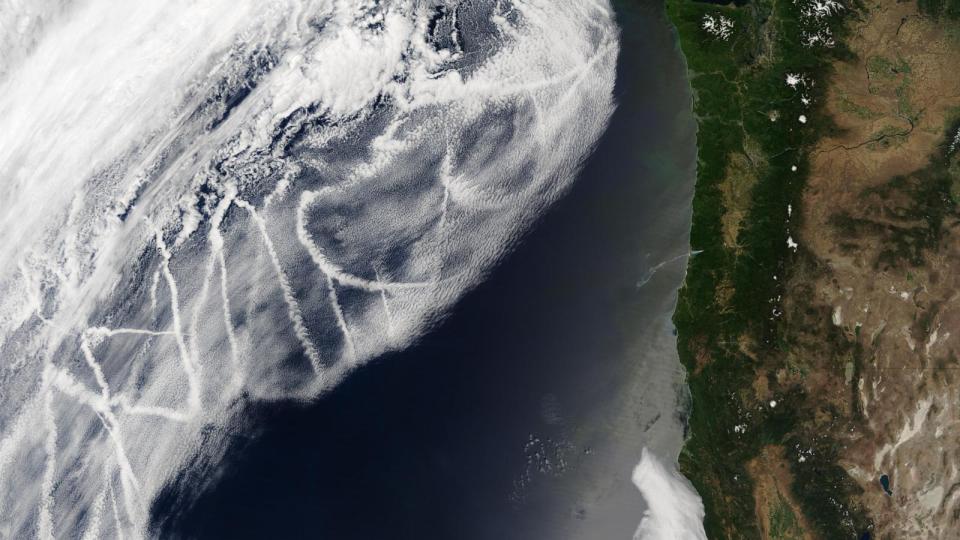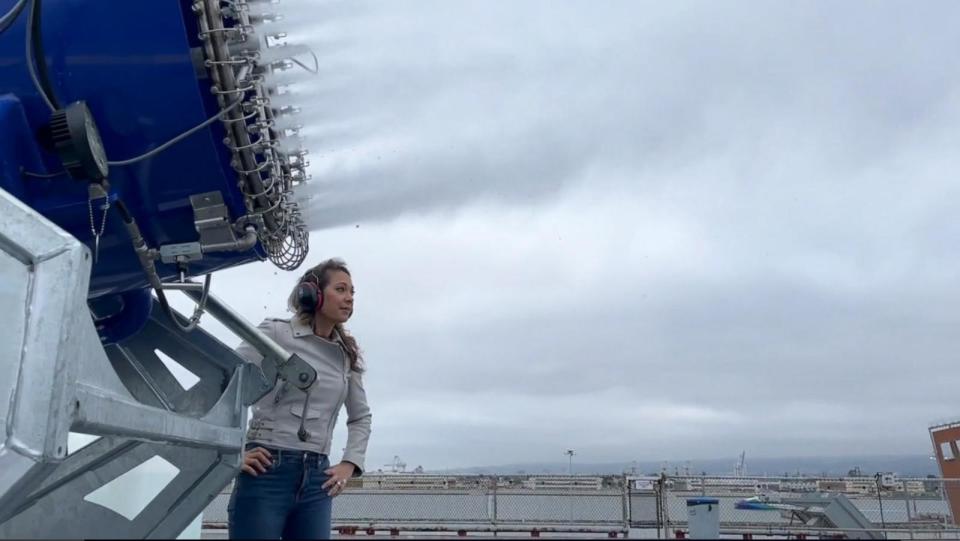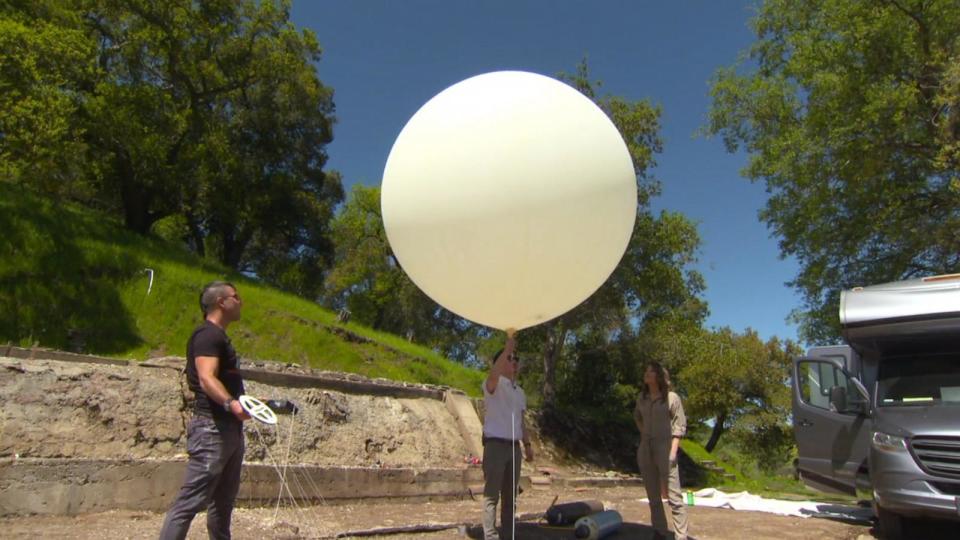Controversial methods to cool the Earth by reflecting sunlight gain traction as global temperatures rise
ABC News is taking a look at solutions for issues related to climate change and the environment with the series, "The Power of Us: People, The Climate, and Our Future."
The planet has been experiencing a relentless stretch of record-breaking global temperatures with the rate and impact of climate change accelerating, according to the World Meteorological Organization.
As the impacts of human-amplified climate change intensify and become more severe, relatively untouched ideas are gaining momentum as potential short-term solutions to lower Earth's temperature.
Solar radiation modification, or solar geoengineering, is a concept that covers several different technologies or approaches to essentially reflect sunlight back into space to manipulate the planet's temperature.
In 2023, the White House published a report laying out a plan to conduct more research on two approaches to solar radiation modification, saying that it's important to better understand the risks and benefits of both technologies.
But solar geoengineering is a controversial topic among scientists, politicians, and the communities concerned about the possible impacts.
While some experts have been researching techniques that could cool the planet for decades, there have been very few experiments in the field and critics argue we don't know enough about potential impacts on weather and climate events, water cycles, or food production.
"We need more scientists from more places who are able to ask the questions about systems that are specific to where they are. We need policymakers that understand the cultural, social, and political dynamics of their communities. We need civil society organizations that understand the dynamics of activism, of accountability, and about how you actually build policy and ideas in the first place. And we need that everywhere," Shuchi Talati, the founder of The Alliance for Just Deliberation on Solar Geoengineering, an organization pushing for more inclusive solar geoengineering research, told ABC News.
Talati says the vast majority of the conversation about solar geoengineering is coming from countries like the United States, so her organization does outreach to communities in the Global South that are being impacted by climate change to share awareness about solar geoengineering as a growing area of research.
MORE: These geoengineering technologies could help combat the climate crisis, scientists say
The increased attention on solar geoengineering research has brought increased scrutiny from critics concerned that mere research makes it more likely a country could choose to deploy these technologies. In 2022, more than 60 climate scientists and experts from around the world signed a letter calling for an agreement to not pursue solar geoengineering.
In the U.S., Tennessee and several other states have considered laws to make it illegal to release chemicals or other substances with the intention of changing the weather or intensity of the sunlight.
ABC News chief meteorologist and chief climate correspondent Ginger Zee joined two teams investigating methods that could one day reflect enough sunlight to help drop temperatures on Earth -- marine cloud brightening and stratospheric aerosol injection.
Marine cloud brightening
While solar radiation modification as a possible climate solution is still at an early stage of research, humans have been unintentionally altering Earth's radiation balance for more than a century.
Sarah Doherty, program director of the Marine Cloud Brightening Project and associate professor at the University of Washington, says that emissions from ships traversing the globe have already been triggering a similar process.

"You can see where ships go over the ocean. The sulfur they're producing from their engines produce small particles in the atmosphere and often leave brightened cloud streaks and we call them ship tracks," Doherty told ABC News.
She says that the marine cloud brightening project that she oversees is studying ways to duplicate the process by essentially making a "clean ship track out of sea salt."
Scientists from the University of Washington and a group called Silver Lining recently began a first of its kind outdoor study to better understand how marine cloud brightening technology could work.
The study consists of blowing tiny particles of salt water into the air and using a variety of research instruments to study the evolution of a sea-salt aerosol plume as it rises higher into the atmosphere.

Scientists say that once the sea-salt aerosols reach stratocumulus clouds in the targeted area, they hope to find the perfectly sized sodium molecules that will give the already existing clouds a boost.
The molecules will help attract more water vapor in the sky to form new water droplets in the cloud. This will effectively make the cloud brighter meaning it can reflect more sunlight. By reducing the amount of sunlight that reaches the Earth's surface, the temperature in that location will effectively decrease.
Kelly Wanser, executive director at the non-profit Silver Lining which advocates for more research around the behavior of aerosols in the atmosphere, says that this technology is still really far from being a full-scale, operational technology and would likely cost billions of dollars to research and develop.
"If we understand the science of what particles do to clouds and how that affects the climate system, it's a win-win, whatever that science turns out to be, because we need to know it to know about pollution and what happens in the near term. And it's what you need to know to know whether marine cloud brightening might be something that you would consider for, you know, lessening climate impacts," Wanser told ABC News.
Stratospheric aerosol injection
While marine cloud brightening would have more localized impacts, another approach to cooling temperatures could have broader impacts.
David Keith, professor in the Department of the Geophysical Sciences at the University of Chicago, has been at the forefront of research for an idea called stratospheric aerosol injection. While research on the topic has been relatively rare, over the last few years, more scientists are studying the topic with some governments also starting to take a closer look.
Keith says that sulfur in the stratosphere can be very effective at offsetting the heating effects of carbon dioxide by reflecting more sunlight. But he emphasized that solar geoengineering alone is not a cure for climate change.
"Any complicated problem like climate change rarely has just one solution. So cutting emissions is certainly a necessary piece. But cutting emissions doesn't solve climate change, because climate change is due to the amount of CO2 that's in the air, and cutting emissions just stops the amount we're adding each year," Keith told ABC News.
"So solar geoengineering can, in combination with emissions cuts and eventually with carbon removal, reduce the overall damage of climate change. That's its promise."
While more research is needed, one company says that the effects of climate change are becoming so dire that more drastic approaches could now be warranted.
Make Sunsets is a company run by founders Luke Iseman and Andrew Song that sells what they call a "cooling credit" where people can pay them to send sulfur dioxide into the atmosphere.

The company says it sends sulfur dioxide into the atmosphere by launching a balloon filled with sulfur dioxide and helium aiming for it to reach the stratosphere, over 60,000 feet in elevation. At this height, the balloon pops and releases the sulfur dioxide into the air.
The goal is to use sulfur dioxide to mimic the cooling effects that volcanic eruptions can have on Earth's global temperature. The United States Geological Survey says that the release of sulfur dioxide into the atmosphere following a volcanic eruption can have one of the most significant climate impacts because the particles reflect sunlight back into space, lowering Earth's temperature.
Make Sunsets say the company has, in total, put less than 75 pounds of sulfur dioxide into the stratosphere over the last year. Iseman admits this is a "negligible" amount but it's just a start.
Academic researchers and governments argue they need to be thorough and proceed with caution, but the two company founders argue we don't have that luxury anymore.
"I summarize it as we've done such a poor job of geoengineering our climate with our carbon emissions over the last several hundred years, that we now need to geoengineering in a positive direction to offset that," Iseman said.
While solar geoengineering discussions continue to heat up, current solar radiation modification efforts are still at a very small scale compared to what would be needed to make a significant impact on Earth's radiation balance and actually cool global temperatures.
But there's a push to focus on researching solar geoengineering as a possible way to address warming and understand the consequences before considering taking these methods full-scale and operational.
Controversial methods to cool the Earth by reflecting sunlight gain traction as global temperatures rise originally appeared on abcnews.go.com

